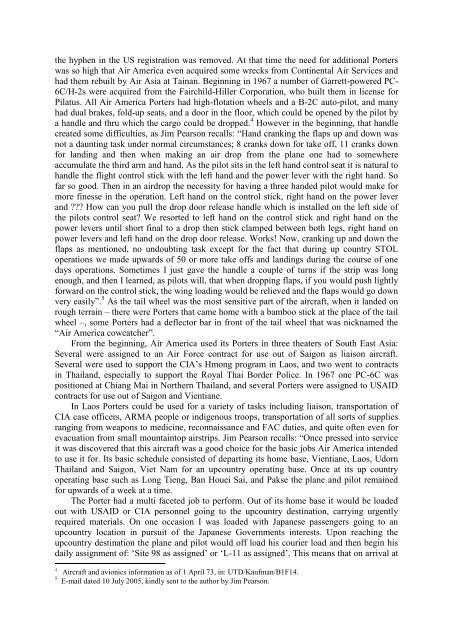air america: pilatus / fairchild pc-6 turbo porters - The University of ...
air america: pilatus / fairchild pc-6 turbo porters - The University of ...
air america: pilatus / fairchild pc-6 turbo porters - The University of ...
You also want an ePaper? Increase the reach of your titles
YUMPU automatically turns print PDFs into web optimized ePapers that Google loves.
the hyphen in the US registration was removed. At that time the need for additional Porters<br />
was so high that Air America even acquired some wrecks from Continental Air Services and<br />
had them rebuilt by Air Asia at Tainan. Beginning in 1967 a number <strong>of</strong> Garrett-powered PC-<br />
6C/H-2s were acquired from the F<strong>air</strong>child-Hiller Corporation, who built them in license for<br />
Pilatus. All Air America Porters had high-flotation wheels and a B-2C auto-pilot, and many<br />
had dual brakes, fold-up seats, and a door in the floor, which could be opened by the pilot by<br />
a handle and thru which the cargo could be dropped. 4 However in the beginning, that handle<br />
created some difficulties, as Jim Pearson recalls: “Hand cranking the flaps up and down was<br />
not a daunting task under normal circumstances; 8 cranks down for take <strong>of</strong>f, 11 cranks down<br />
for landing and then when making an <strong>air</strong> drop from the plane one had to somewhere<br />
accumulate the third arm and hand. As the pilot sits in the left hand control seat it is natural to<br />
handle the flight control stick with the left hand and the power lever with the right hand. So<br />
far so good. <strong>The</strong>n in an <strong>air</strong>drop the necessity for having a three handed pilot would make for<br />
more finesse in the operation. Left hand on the control stick, right hand on the power lever<br />
and ??? How can you pull the drop door release handle which is installed on the left side <strong>of</strong><br />
the pilots control seat? We resorted to left hand on the control stick and right hand on the<br />
power levers until short final to a drop then stick clamped between both legs, right hand on<br />
power levers and left hand on the drop door release. Works! Now, cranking up and down the<br />
flaps as mentioned, no undoubting task except for the fact that during up country STOL<br />
operations we made upwards <strong>of</strong> 50 or more take <strong>of</strong>fs and landings during the course <strong>of</strong> one<br />
days operations. Sometimes I just gave the handle a couple <strong>of</strong> turns if the strip was long<br />
enough, and then I learned, as pilots will, that when dropping flaps, if you would push lightly<br />
forward on the control stick, the wing loading would be relieved and the flaps would go down<br />
very easily”. 5 As the tail wheel was the most sensitive part <strong>of</strong> the <strong>air</strong>craft, when it landed on<br />
rough terrain – there were Porters that came home with a bamboo stick at the place <strong>of</strong> the tail<br />
wheel –, some Porters had a deflector bar in front <strong>of</strong> the tail wheel that was nicknamed the<br />
“Air America cowcatcher”.<br />
From the beginning, Air America used its Porters in three theaters <strong>of</strong> South East Asia:<br />
Several were assigned to an Air Force contract for use out <strong>of</strong> Saigon as liaison <strong>air</strong>craft.<br />
Several were used to support the CIA‟s Hmong program in Laos, and two went to contracts<br />
in Thailand, especially to support the Royal Thai Border Police. In 1967 one PC-6C was<br />
positioned at Chiang Mai in Northern Thailand, and several Porters were assigned to USAID<br />
contracts for use out <strong>of</strong> Saigon and Vientiane.<br />
In Laos Porters could be used for a variety <strong>of</strong> tasks including liaison, transportation <strong>of</strong><br />
CIA case <strong>of</strong>ficers, ARMA people or indigenous troops, transportation <strong>of</strong> all sorts <strong>of</strong> supplies<br />
ranging from weapons to medicine, reconnaissance and FAC duties, and quite <strong>of</strong>ten even for<br />
evacuation from small mountaintop <strong>air</strong>strips. Jim Pearson recalls: “Once pressed into service<br />
it was discovered that this <strong>air</strong>craft was a good choice for the basic jobs Air America intended<br />
to use it for. Its basic schedule consisted <strong>of</strong> departing its home base, Vientiane, Laos, Udorn<br />
Thailand and Saigon, Viet Nam for an u<strong>pc</strong>ountry operating base. Once at its up country<br />
operating base such as Long Tieng, Ban Houei Sai, and Pakse the plane and pilot remained<br />
for upwards <strong>of</strong> a week at a time.<br />
<strong>The</strong> Porter had a multi faceted job to perform. Out <strong>of</strong> its home base it would be loaded<br />
out with USAID or CIA personnel going to the u<strong>pc</strong>ountry destination, carrying urgently<br />
required materials. On one occasion I was loaded with Japanese passengers going to an<br />
u<strong>pc</strong>ountry location in pursuit <strong>of</strong> the Japanese Governments interests. Upon reaching the<br />
u<strong>pc</strong>ountry destination the plane and pilot would <strong>of</strong>f load his courier load and then begin his<br />
daily assignment <strong>of</strong>: „Site 98 as assigned‟ or „L-11 as assigned‟. This means that on arrival at<br />
4 Aircraft and avionics information as <strong>of</strong> 1 April 73, in: UTD/Kaufman/B1F14.<br />
5 E-mail dated 10 July 2005, kindly sent to the author by Jim Pearson.

















